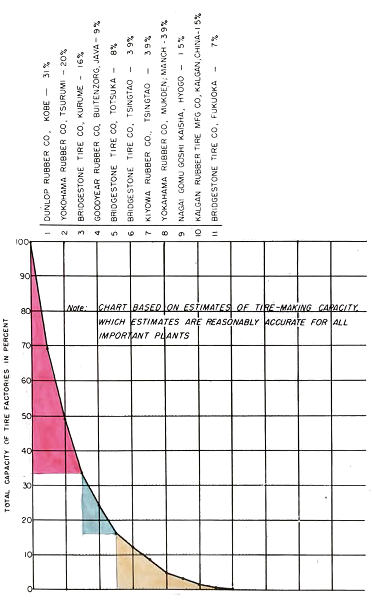
|
REQUIREMENTS FOR AIR ASCENDANCY Tab B Japanese Theatre - Appendix J-VIII Rubber |
|
No. |
Name and Location |
Capacity in tires per day |
Percent Japan Total |
|
1. |
Dunlop Rubber Company - Nada (Kobe) |
2,715 |
30.9 |
|
2. |
Yokohama Rubber Co. - Tsurumi |
1,780 |
20.3 |
|
3. |
Bridgestone Tire Co. - Kurume |
1,395 |
15.9 |
|
4. |
Goodyear Rubber Co. - Buitenzorg, Java |
750 |
8.5 |
|
5. |
Bridgestone Tire Co. - Totsuka |
711 |
8.1 |
|
6. |
Bridgestone Tire Co. - Tsingtao, China |
345 |
3.9 |
|
7. |
Kiyowa Rubber Co. - Tsingtao, China |
345 |
3.9 |
|
8. |
Yokohama Rubber Co. - Mukden, Manch. |
345 |
3.9 |
|
9. |
Nagai Gomu Goshi Kaisha - Hyogo |
135 |
1.5 |
|
10. |
Kalgan Rubber Tire Mfg. Co. - Kalgan, China |
135 |
1.5 |
|
11. |
Bridgestone Tire Co. - Fukuoka |
67 |
0.8 |
|
12. |
Tokyo Rubber Engineering Co. - Unknown |
67 |
0.8 |
|
13. |
Japan Auto & Aircraft Tire Co. - Tokyo |
– |
– |
|
14. |
(Unknown) - Shanghai, China |
– |
– |
|
|
TOTAL |
8,790 |
100.0 |
|
SUMMARY: 1. Vulnerability of the Industry: As the above data indicate, the output of rubber tires for trucks, aircraft, and other vitally necessary vehicles is concentrated in a very few factories. About 67% of the known tire-making capacity in all of Japanese-occupied territory is located in three large plants; the first five plants account for about 84% of the total. On the basis of information at hand, it seems highly unlikely that the Japanese have any considerable Inventory of tires. Not only is the tire output highly concentrated, but it would be difficult to convert other rubber factories to ths production of tires in the event that any of the leading plants should be bombed. Although stoppage of the flow of rubber tires can be effectively accomplished by destroying a few key factories, it would be impossible to achieve the same result through attacking the raw material sources. Rubber is extensively grown throughout the South Pacific area—Indo-China, Malaya, Java, Sumatra, Borneo—and any one of these countries produces enough crude rubber to supply Japan’s material requirements. In order to cut off the Nipponese sources of crude rubber, millions of acres of rubber trees would have to be burned or sprayed with poisonous chemicals. 2. Military and Industrial Uses: Rubber tires are necessary equipment for all types of army aircraft and for all types of naval aircraft based on carriers. Army scout cars, gun caissons and carriers, mobile kitchens, ambulances, and all other military trucks and motor vehicles are equipped with tires. In short, the very existence of the modern mechanized, mobile army presupposes the liberal use of rubber tires. |
|||
1. DESCRIPTION OF TARGETS
The rubber and tire making works comprise a complex of buildings in which the various operations are carried out. This is a type of target which will probably be susceptible to incendiary attack.
2. NUMBER OF DIRECT HITS AND TYPE OF BOMBS REQUIRED
It is considered desirable to use 600 lb. bombs on this type of objectives. The weight of attack should be such that not less than fifty (50) of these bombs fall within the target aiming area of 1000' by 1000'. In certain of the larger plants more than one aiming point would be taken.
3. NUMBER OF SORTIES AND BOMBER FORCE REQUIRED
Based upon detailed calculations taking into account all operational factors Involved in making attacks against highly defended targets with appropriate allowances for probabilities, aiming errors, losses, etc., etc., it appears that to deal effectively with the fourteen (14) targets proposed in this system, it will be necessary to have a total oft-
1,320 SORTIES
In order to carry out these sorties in sixty (60) operational days, a force of;-
3 - B 29's
19 - B 17e’s
must be set up.